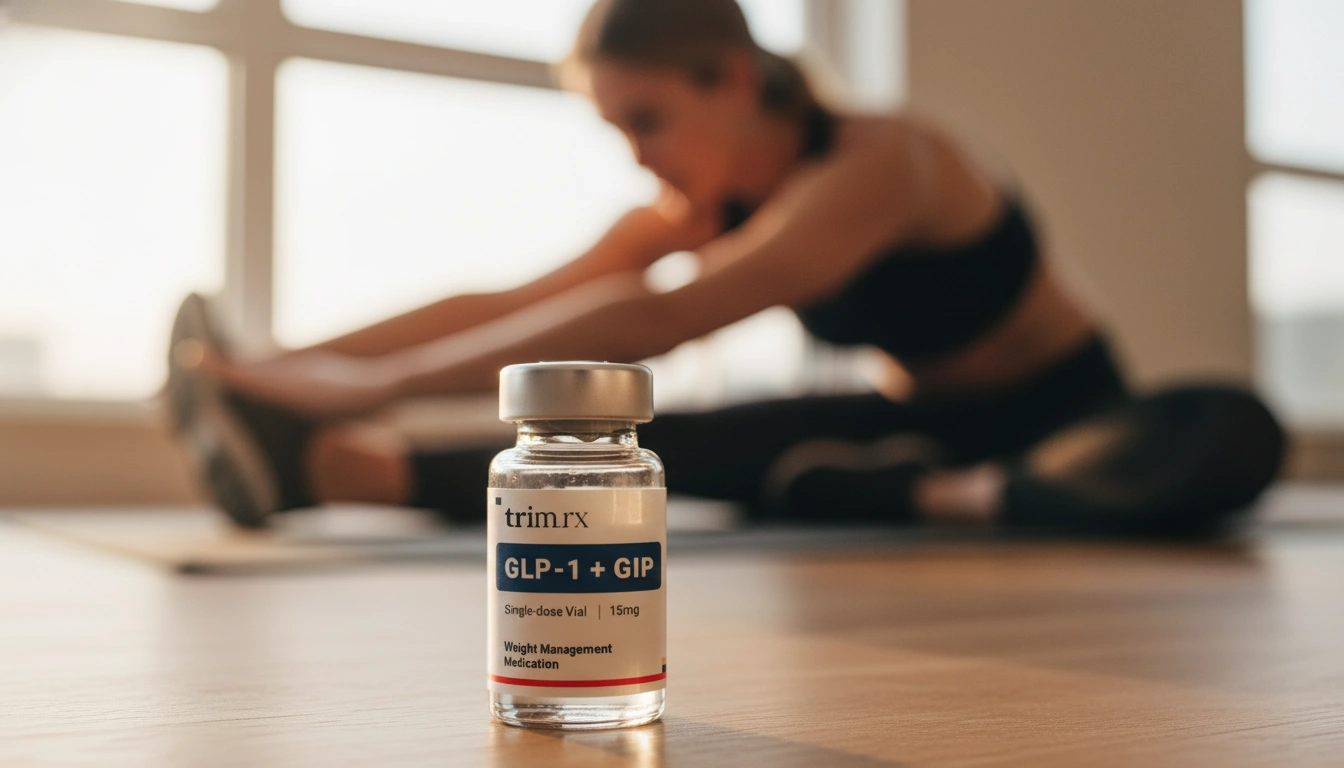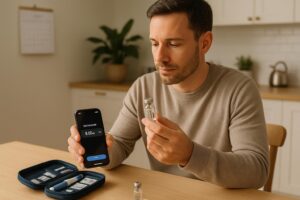What Time of Day to Take GLP-1 for Optimal Results

Introduction
Have you ever wondered how the timing of your medication can impact its effectiveness? With the rise of GLP-1 medications, such as Ozempic and Wegovy, many individuals are asking themselves the pivotal question: What time of day should I take GLP-1? This inquiry is vital for those seeking effective management of weight loss and blood sugar levels.
Recent studies have highlighted that the timing of medication can significantly affect its efficacy and the management of side effects. For instance, many individuals report varying experiences based on whether they take their injections in the morning or evening. Given the personalized nature of weight loss solutions, particularly with GLP-1 medications, understanding the nuances of timing can empower you to optimize your treatment plan.
At TrimRx, our mission is to support you on your journey towards healthier living through personalized, medically supervised care. In this blog post, we aim to provide clarity on when to take GLP-1 medications, incorporating insights from our values of science, empathy, and transparency. We’ll explore the implications of timing, address common concerns, and share tips to help you navigate your weight management journey effectively.
By the end of this article, you will gain a comprehensive understanding of the best practices for timing your GLP-1 injections, helping you to enhance their effectiveness while minimizing discomfort. So, let’s delve into the intricacies of GLP-1 medication timing and what factors come into play.
Understanding GLP-1 Medications
What is GLP-1?
GLP-1, or glucagon-like peptide-1, is a hormone that plays a crucial role in regulating appetite, insulin secretion, and glucose metabolism. GLP-1 medications, such as Ozempic, Wegovy, and Mounjaro, mimic this hormone’s effects to help manage blood sugar levels and support weight loss. These medications are typically prescribed alongside a healthy diet and exercise as part of a comprehensive weight management strategy.
How Do GLP-1 Medications Work?
GLP-1 medications work by promoting feelings of fullness, slowing gastric emptying, and enhancing insulin sensitivity. By mimicking the effects of natural GLP-1, these medications can help reduce appetite and caloric intake, making them valuable tools in weight loss and diabetes management.
Why Timing Matters
The timing of your GLP-1 injection can influence how effectively the medication works and how well you tolerate it. While some individuals may prefer to take their injections in the morning, others may find that evening doses help mitigate side effects such as nausea. Understanding how your body responds to these medications can guide you in finding the most effective routine.
When Should You Take GLP-1 Medications?
Morning vs. Night: What Works Best for You?
- Morning Injections:
- Benefits: Taking your GLP-1 medication in the morning can help you start your day with appetite control, potentially reducing the urge to snack throughout the day. Many individuals also find it easier to remember to take their medication in the morning as part of their morning routine.
- Considerations: If you experience side effects like nausea, taking your injection in the morning might lead to discomfort during daily activities.
- Evening Injections:
- Benefits: For those sensitive to side effects, evening injections can provide relief, allowing you to sleep through any discomfort. Evening doses can be particularly beneficial for individuals who tend to experience nausea after their injections, as they can sleep through the worst of the symptoms.
- Considerations: If you often have late-night cravings or large dinners, evening injections might help curb those impulses.
Key Factors to Consider
- Personal Preference: Ultimately, the best time to take your GLP-1 medication is when it fits seamlessly into your daily routine. Consistency is key; aim to take your medication at the same time each week.
- Side Effects: Monitor how your body reacts to the medication at different times of day. If you notice that nausea is less severe when taken in the evening, it may be worth adjusting your schedule accordingly.
- Meal Timing: GLP-1 medications do not need to be taken with food, but meal timing can still play a role in how you feel after taking the medication. Some individuals find it helpful to take their injection shortly before meals to enhance feelings of fullness and reduce portion sizes.
Tips for a Smooth Injection Routine
- Choose a Consistent Time: Whether it’s morning or night, pick a time that works for you and stick to it. This consistency helps ensure stable medication levels in your body.
- Set Reminders: Use phone alarms or calendar notifications to help you remember your injection day and time.
- Prepare Ahead: Keep your medication and supplies easily accessible. If necessary, store your GLP-1 medication as directed—usually in the refrigerator—until you’re ready to use it.
- Track Your Symptoms: Keep a journal of how you feel after each injection. This can help you identify patterns and make adjustments as needed.
The Role of TrimRx in Your GLP-1 Journey
At TrimRx, we understand that navigating weight loss and medication management can be challenging. Our personalized weight loss programs, which include medically supervised care and ongoing support, are designed to empower you on your journey.
By taking our free assessment quiz, you can discover if you qualify for our prescription weight loss medications, including Semaglutide and Tirzepatide. Our goal is to provide you with a tailored treatment plan, ensuring you receive the right support for your unique needs.
If you’re looking for quick-access supplements to enhance your weight loss journey, consider our GLP-1 Daily Support and Weight Loss Boost products, which can complement your GLP-1 treatment.
Conclusion
In conclusion, the best time to take your GLP-1 medication ultimately depends on your personal routine, tolerance to side effects, and lifestyle. Morning or evening, the key takeaway is to find a consistent time that works best for you and stick to it. By understanding the nuances of timing and how it interacts with your body, you can enhance the effectiveness of your treatment and support your weight management goals.
As you embark on your journey with GLP-1 medications, remember that TrimRx is here to assist you every step of the way. Our commitment to science, empathy, and personalized care ensures that you receive the support you need to achieve lasting results. Take our free assessment quiz today to get started on your path to a healthier lifestyle.
FAQ
Can I take GLP-1 medications with food?
GLP-1 medications can be taken with or without food. However, some individuals prefer to take them before meals to enhance feelings of fullness.
What if I miss a dose?
If you miss a dose of your GLP-1 medication, take it as soon as you remember within the same week. If it’s been over a week, skip the missed dose and return to your regular schedule.
How can I manage side effects?
To manage side effects like nausea, consider taking your injection at night or after a small, protein-rich snack. Staying hydrated and avoiding greasy or spicy foods can also help.
Are there any specific precautions I should take?
Always consult with your healthcare provider regarding any allergies, existing medical conditions, or interactions with other medications before starting GLP-1 treatment.
How long does it take to see results from GLP-1 medications?
Many individuals begin to notice changes in appetite and weight within a few weeks of starting GLP-1 medications, with more substantial results often seen after several months of consistent use.
By proactively managing your medication routine and working with TrimRx, you can pave the way for a successful weight loss journey.

Transforming Lives, One Step at a Time
Keep reading
7 Tips for Sticking to GLP-1 Injection Schedules
Seven practical strategies to keep weekly GLP‑1 injections on schedule—pick a routine day, set reminders, manage side effects, rotate sites, and avoid missed doses.
Custom GLP-1 Dosing for Kidney Disease
Personalized GLP-1 dosing for CKD patients with monitoring, dehydration and hypoglycemia risk mitigation, and guidance across all kidney disease stages.
Semaglutide vs Tirzepatide: Approved Uses
Two leading diabetes and weight-loss drugs differ in FDA-approved benefits — one adds heart, kidney and liver protection; the other treats obstructive sleep apnea.



